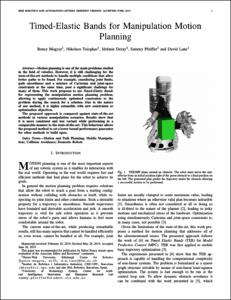Mostra el registre d'ítem simple
Timed-elastic bands for manipulation motion planning
| dc.contributor.author | Magyar, Bence |
| dc.contributor.author | Tsiogkas, Nikolaos |
| dc.contributor.author | Deray, Jeremie |
| dc.contributor.author | Pfeiffer, Sammy |
| dc.contributor.author | Lane, David |
| dc.contributor.other | Universitat Politècnica de Catalunya. Doctorat en Automàtica, Robòtica i Visió |
| dc.date.accessioned | 2020-03-27T13:50:27Z |
| dc.date.available | 2020-03-27T13:50:27Z |
| dc.date.issued | 2019-10-01 |
| dc.identifier.citation | Magyar, B. [et al.]. Timed-elastic bands for manipulation motion planning. "IEEE robotics and automation letters", 1 Octubre 2019, vol. 4, núm. 4, p. 3513-3520. |
| dc.identifier.issn | 2377-3766 |
| dc.identifier.uri | http://hdl.handle.net/2117/182055 |
| dc.description | © 2019 IEEE. Personal use of this material is permitted. Permission from IEEE must be obtained for all other uses, in any current or future media, including reprinting/republishing this material for advertising or promotional purposes, creating new collective works, for resale or redistribution to servers or lists, or reuse of any copyrighted component of this work in other works. |
| dc.description.abstract | Motion planning is one of the main problems studied in the field of robotics. However, it is still challenging for the state-of-the-art methods to handle multiple conditions that allow better paths to be found. For example, considering joint limits, path smoothness and a mixture of Cartesian and joint-space constraints at the same time pose a significant challenge for many of them. This letter proposes to use timed-elastic bands for representing the manipulation motion planning problem, allowing to apply continuously optimized constraints to the problem during the search for a solution. Due to the nature of our method, it is highly extensible with new constraints or optimization objectives. The proposed approach is compared against state-of-the-art methods in various manipulation scenarios. The results show that it is more consistent and less variant, while performing in a comparable manner to that of the state of the art. This behavior allows the proposed method to set a lower-bound performance guarantee for other methods to build upon. |
| dc.format.extent | 8 p. |
| dc.language.iso | eng |
| dc.publisher | Institute of Electrical and Electronics Engineers (IEEE) |
| dc.rights | Attribution-NonCommercial-NoDerivs 3.0 Spain |
| dc.rights.uri | http://creativecommons.org/licenses/by-nc-nd/3.0/es/ |
| dc.subject | Àrees temàtiques de la UPC::Informàtica::Automàtica i control |
| dc.subject.other | Motion and path planning |
| dc.subject.other | mobile manipulation |
| dc.subject.other | collision avoidance |
| dc.subject.other | domestic robots |
| dc.title | Timed-elastic bands for manipulation motion planning |
| dc.type | Article |
| dc.contributor.group | Universitat Politècnica de Catalunya. VIS - Visió Artificial i Sistemes Intel·ligents |
| dc.identifier.doi | 10.1109/LRA.2019.2927956 |
| dc.description.peerreviewed | Peer Reviewed |
| dc.subject.inspec | Classificació INSPEC::Control theory::Predictive control |
| dc.relation.publisherversion | https://ieeexplore.ieee.org/document/8758897 |
| dc.rights.access | Open Access |
| local.identifier.drac | 25830929 |
| dc.description.version | Postprint (author's final draft) |
| local.citation.author | Magyar, B.; Tsiogkas, N.; Deray, J.; Pfeiffer, S.; Lane, D. |
| local.citation.publicationName | IEEE robotics and automation letters |
| local.citation.volume | 4 |
| local.citation.number | 4 |
| local.citation.startingPage | 3513 |
| local.citation.endingPage | 3520 |
Fitxers d'aquest items
Aquest ítem apareix a les col·leccions següents
-
Articles de revista [164]
-
Articles de revista [139]


